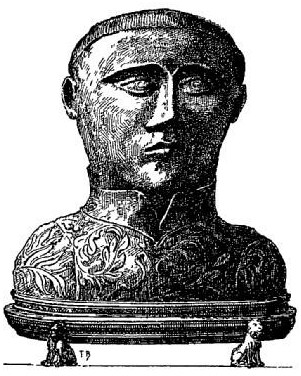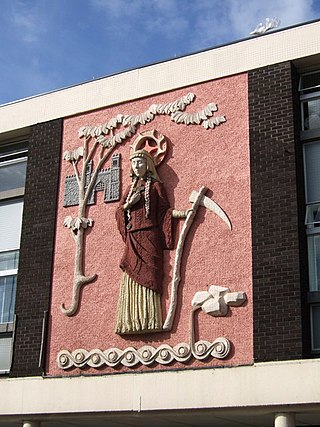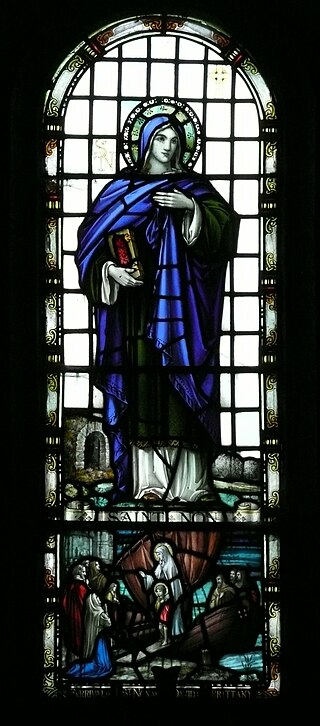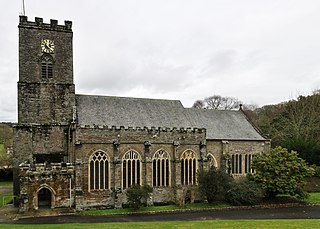
Agnes of Rome is a virgin martyr, venerated as a saint in the Catholic Church, Oriental Orthodox Church and the Eastern Orthodox Church, as well as the Anglican Communion and Lutheran Churches. She is one of several virgin martyrs commemorated by name in the Canon of the Mass.

Piran or Pyran, died c. 480, was a 5th-century Cornish abbot and saint, possibly of Irish origin. He is the patron saint of tin-miners, and is also generally regarded as the patron saint of Cornwall, although Michael and Petroc also have some claim to this title.

Wenna was a medieval princess and Christian martyr who flourished in Wales and Cornwall. Later venerated as a saint, she is honored at multiple churches in Cornwall and Devon.
Breage or Breaca is a saint venerated in Cornwall and South West England. According to her late hagiography, she was an Irish nun of the 5th or 6th century who founded a church in Cornwall. The village and civil parish of Breage in Cornwall are named after her, and the local Breage Parish Church is dedicated to her. She is a saint in the Eastern Orthodox Church and Catholic Church.

St Ive is a village in the civil parish of St Ive and Pensilva in eastern Cornwall, England, United Kingdom. The village is split into four parts: St Ive Church End, St Ive Cross, St Ive Keason and St Ive Parkfield. In addition to the parish an electoral ward exists stretching north of St Ive. The population at the 2011 census was 4,246.

March 4 - Eastern Orthodox liturgical calendar - March 6
Kea was a late 5th-century British saint from the Hen Ogledd —the Brythonic-speaking parts of what is now southern Scotland and northern England. According to tradition he was chiefly active in Cornwall, Devon and Brittany, and his cult was popular in those regions as well as throughout Wales and the West Country. Fili or Filius, to whom the parish church of Philleigh is dedicated, probably came from Wales and is said to have been a companion of Kea.

Winwaloe was the founder and first abbot of Landévennec Abbey, also known as the Monastery of Winwaloe. It was just south of Brest in Brittany, now part of France.

Sidwell was a virgin saint from the English county of Devon, She is the patron saint of Exeter and sister to Juthwara.

Non was, according to Christian tradition, the mother of Saint David, the patron saint of Wales.

St Ia's Church, St Ives, is a parish church in the Church of England in St Ives, Cornwall, UK. It is dedicated to Ia of Cornwall, a 5th- or 6th-century Irish saint, and is a Grade I listed building.

Saint Materiana is a Welsh saint, patron of two churches in Cornwall and one in Wales.

Christianity in Cornwall began in the 4th or 5th century AD when Western Christianity was introduced as in the rest of Roman Britain. Over time it became the official religion, superseding previous Celtic and Roman practices. Early Christianity in Cornwall was spread largely by the saints, including Saint Piran, the patron of the county. Cornwall, like other parts of Britain, is sometimes associated with the distinct collection of practices known as Celtic Christianity but was always in communion with the wider Catholic Church. The Cornish saints are commemorated in legends, churches and placenames.
Elwen was the name of an early saint or saints venerated in Cornwall and Brittany. The hagiographical material asserts that he came to Cornwall from Ireland in the company of Breage and six others, but this is attested late. A chapel at Porthleven in Sithney parish, Cornwall, dedicated to Elwen, existed from the 13th century until 1549, and in Brittany several sites and placenames are associated with possibly related figures.
Saint Senara, also known as Asenora, Sinara, or Sennara, is a legendary Cornish saint with links to the village of Zennor on the north coast of Cornwall, UK. The Church of Saint Senara, Zennor is dedicated to her, and according to legend her name inspired the name of the village of Zennor along with local features like Zennor Head and Zennor Quoit.

Menefrida is the 5th-century Cornish saint associated with the parish of St Minver, near the Camel estuary in Cornwall, England. Alternative spellings of her name include Menefreda, Menwreda, Menfre, Mynfreda and Minefreda. At the time of King Henry VIII the parish was known as St. Menifryde.

Saint Noyale, also known as Noaluen, was a semi-legendary 5th-century Celtic saint and virgin martyr. She is a popular saint in both Brittany and Cornwall, where she is memorialized at Newlyn East. According to legend, it is there that a fig tree growing from the south wall of the church grew from Noyale's staff. A holy well nearby was the site of her martyrdom. She was one of the numerous Celtic settlers who travelled to Brittany during the Anglo-Saxon invasion of England.

Tetha, also known as Teath, Tecla, and by a variety of other names, was a 5th-century virgin and saint in Wales and Cornwall. She is associated with the parish church of St Teath in Cornwall. Baring-Gould gives her feast day as 27 October, but this has been called a mistaken conflation with Saint Ia. In 1878, it was held on the movable feast of Whit Tuesday. Other sources place it on 1 May, 6 September, and (mistakenly) 15 January. It is no longer observed by either the Anglican or Catholic church in Wales.

Saint Julitta, or Saint Juliot, is a male Celtic saint to whom two Cornish churches are dedicated. He is believed to have settled at the site of Tintagel Castle at the end of the 5th century and established a small monastic community. In some accounts he is a member of the Children of Brychan and St Nectan and the holy female Hermit, St Keyne, are thought to have been his companions. He is the patron of the parish churches of St Juliot and of Lanteglos by Camelford. The Norman chapel of Tintagel Castle is dedicated to St Julitta. At Jetwells near Camelford is a holy well. Jetwells derives from "Juliot's well".
Rumon of Tavistock is a saint venerated in the traditions of the Catholic, Anglican Communion, and Western Orthodox churches.

















